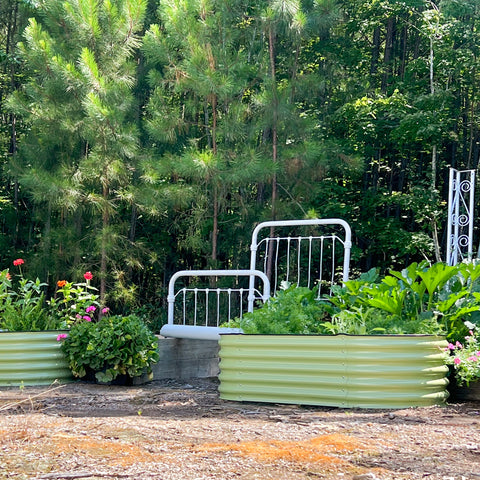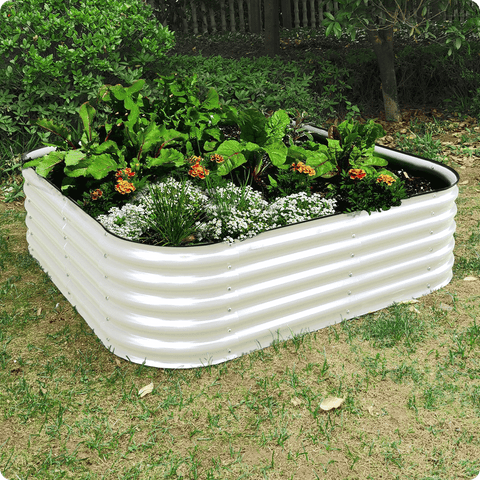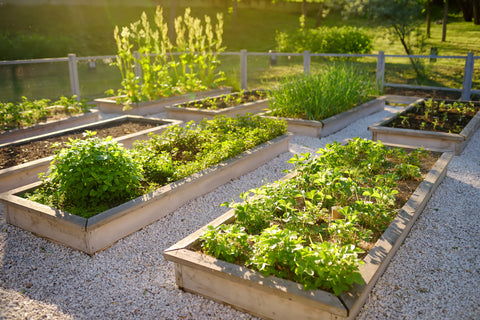Raised Garden Beds - A Effective Way to Keep Rabbits Away from The Garden
As a senior vegetable gardener, I found that row after row of bush beans sprouted, grew one or two inches long, and then were consumed within a day, which was also frustrating. What does the gardener have to do with these lovely pests? The following content also has some reference value for raised garden beds.
I am pleased to report that there are solutions. You don't have to resort to hunting these small animals. I'm sorry, Elmer Ford.
Instead, take a few minutes to become familiar with the rabbit's behavior. This will help you understand and provide ways to stop their habit of "all gardens are my salad bars" without using violence.
Choose plants carefully and tidy your yard and garden right there. Live, let live? I have some advice on how to have a prosperous garden and coexist with the occasional rabbit invader.

The following is what I will share for those who implement the drive of rabbits out of the garden:
Is this really a rabbit injury?
Don't shoot!
Why the raised bed is effective
Enclose them
Landscaping and finishing to stop rabbits
Planting plants they don't like
Use smell on them
Is this really a rabbit injury?
The damage you observe on young flower seedlings or vegetable buds is likely to be caused by another pest.
Bites and holes on green or other plants are not rabbit style. This type of plant damage comes from slugs or snails.
Rabbits are much more accurate. They completely cut the main stem of the seedling, and the result looks like scissors, not sharp teeth.
If you have nothing but small pieces, it may be the rabbit's injury.
Cotton tail will also gnaw the bark of young trees. You can say it's them, not deer, because their markers can only rise a few feet at most.
You can confirm that they are causing damage by looking for their small round faeces around the crime scene.
Once you have identified the garden pests you are dealing with, you can come up with a strategy to protect plants and flowers.

Don't shoot!
If you are already a hunter or have a gun at home, you may think of trying to use fire to eliminate your rabbit intrusion. I strongly oppose this practice.
First of all, if you live in a city, there are restrictions on shooting guns in most places. In addition, you risk harming other wildlife or scaring your neighbors.
In more rural areas, dealing with corpses also has complications, and there is no guarantee that you will achieve your goals.
In fact, unless you plan to spend a lot of time waiting for prey to appear, once rabbits chase your garden, you may not be able to keep up with the rapidly growing rabbit population.
Since these numbers run counter to your potential to successfully eliminate these garden pests by shooting them one by one, I encourage you to focus on the following prevention methods, which are applicable to any rabbit who may try to build your garden as a family buffet.
Why the raised garden bed is effective
Although you may think rabbits are jumping animals, they can't really reach too much height.
Cotton tail can jump up to two feet, while Jack Rabbit may jump higher, but usually only when they are chased by the neighbor's dog.
This means that the first line of defense is a garden bed at least two feet high on the side. If this is impractical for a large vegetable garden, or rabbits are chasing your landscape plants, you need to try other strategies.
Or, you can classify and only plant flowers and vegetables that are most attractive to rabbits on the elevated bed, leaving the underground patch to plants that are not good for Peter, Flopsy and Mopsy.

Enclose them
If garden beds are not feasible, or can only be used in part of your growing space, you can also consider some fences.
Since most rabbits cannot jump more than two feet off the ground, the fence only needs to be about 26 inches high.
This is a relief for flower gardeners, because when it is only a few feet tall, it is easier to find an attractive or elegant fence option.
However, you do need to ensure that the openings in the mesh or fence rails do not exceed a few inches.
Rabbits can squeeze through anything wider, although if they can find what they like to eat outside this barrier, they will not do so.
Also dig a trench and place a fence at least 10 inches below the soil. Cotton tails are not powerful excavators, but if you allow them, they can uproot a little soil and drill under the fence.
Remember that flowering plants and seedlings are particularly attractive when young and tender.
So, if you don't want to disturb the fence, try at least putting some nets on the plants you bought when you just brought them home from the nursery and put them underground. That was when they were most vulnerable.
Landscaping and finishing to stop rabbits
As gardeners, it is easy to feel that invasive pests are the problem, and we are forced to deal with them.
But in this case, we can actually help create a place to provide rabbits with an attractive meal choice without destroying our precious edible seedlings and carefully cultivated ornamental plants.
As prey, rabbits are looking for a safe place where there is food nearby. Who can blame them if they settle in a garden near piles of bushes or leaves?
Stopping them is a two-part process. First, eliminate all the messy places in the yard where they want to hide or nest.
This includes shrubs, patches with weeds and shrubs around landscape shrubs.
Second, make sure they have a more attractive place on the far edge of your property, or at least a few yards away from the plants and flowers you want to keep.
Replacing the rabbit oasis may be very simple, for example, leaving a clover uncut in the yard.
Or you can plant something easy to plant, which is very delicious for small jumping insects. Think of it as a trap crop, but not suitable for insects.
Plant these delicious tidbits where they are easier to reach than your precious morning glory or newly sprouted cucumber.
Because they have been running away to avoid eagles, owls, neighbor dogs, etc. Trust me: they will choose the things you grow, which are located in the first place.
Rabbits are the original fans of "low-lying fruits".
Some gardeners may think that this "living and letting live" is a bit excessive. But I like to think that when I grow several mungbean plants in the field, I am pragmatic and gentle, so that my harvest will not be affected.
Planting plants they don't like
Different from humans, humans are very persistent about which flowers they think can be eaten. Our rabbit friends will also eat zinnia, mustard, dahlia and thousands of other flowers.
They also eat vegetables, stems (if they are soft), fruits (including tomatoes), and vegetables from corn to cucumbers to peppers.
If you notice that your garden is attractive, you may want to choose some plants that rabbits will not eat.
Some of the flowers on the list include Mexican marigold, dusty mills, lavender, yarrow, iris grass, Russian sage and Stylophorum.
In terms of vegetables, they avoided all onions. If you have never planted onions, chives, leeks or garlic, this may be your opportunity!
However, if your passion is gladiolus and wax gourd, you will not be willing to plant only Russian sage and chives.
But you can choose to put the rabbit's favorite plants in the elevated bed or fence area, and plant the plants they ignore in the garden that you cannot easily protect.

Use smell on them
If you have tried all these strategies, but still feel that you are the reluctant owner of the 24-hour salad bar, please consider the rabbit's sense of smell.
For example, scattering bone powder around the plant you most want is a natural deterrent, although it also smells bad to humans.
You can also let your dog leave his scent and make a commotion when he does.
Let Fido play near the garden in the evening. The cute furry animals may cross your garden from their safe harbor list.
However, don't go to the myth of camphor pill. Although they may play a deterrent role for a period of time, they can only work in a narrow space.
They contain unsafe chemicals used around vegetables or any edible plant.
They have pesticides (hence the name camphor pill), which can kill many insects and may harm other types of wild animals or young people.
There's nothing to see here, Peter Rabbit
Even if you don't have a vulnerable child in this place, the simplest way is to try to take all measures to prevent rabbits from harming, without eliminating cute animals.
Nobody likes Mr. McGregor and that dog pitchfork, you know.
The less attractive your garden and yard are, the fewer rabbits you will have. Because they are often hunted, they will find the simplest shelter and food source they encounter.
Don't let your garden become the bed and breakfast of FooFoo. You may avoid most of the problems they may cause.
If rabbits eat these, I will still get my "real crops" on the bed in the distant raised garden.
